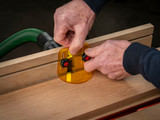Can a Circular Saw Be Converted Into a Track Saw?
Track and circular saws serve distinct purposes in the world of woodworking and construction. While both tools can make straight cuts, they have significant differences that typically prevent a straightforward conversion from one tool to the other. Here are some key reasons why a circular saw can't convert into a track saw.
Base Design
One of the primary differences between a circular saw and a track saw is their base design. A track saw features a specialized base with a groove that fits perfectly onto a guide rail or track. This design ensures a stable and precise cut along the length of the track.
In contrast, a circular saw has a flat and open base, which lacks the necessary components to securely attach to a guide rail. While adapter kits exist, they often come with trade-offs, such as requiring you to use a certain manufacturer’s guide rail, reducing the plunge depth of the circular saw, and forcing you to adapt to a time-consuming conversion process.
Dust Extraction
Many track saws have built-in dust extraction systems that efficiently capture and remove sawdust and debris during cutting. This feature contributes to a cleaner and healthier work environment.
Circular saws typically lack integrated dust extraction systems. Retrofitting a circular saw with a compatible dust extraction system can be complex and may compromise the saw's performance and safety.
Precision and Accuracy
Track saws create precise and accurate cuts, thanks to their base design and the guidance from the track. Circular saws can't achieve the same level of precision and accuracy as most track saws. Achieving consistent straight cuts can be challenging without the proper alignment and support from a track saw's base and guide rail.
Safety Considerations
Safety is a top priority in woodworking. Track saws have safety features and mechanisms specific to their operation.
For example, many new track saws feature anti-kickback technology and anti-tip features specific to the saw and guide rail pairing.
Cost and Feasibility
Even if it were technically possible to convert a circular saw into a track saw, the cost and feasibility of such a conversion could be prohibitive. The expenses of modifying the base, adding dust extraction components, and implementing safety features might exceed the cost of purchasing a dedicated track saw.
Final Thoughts
While circular saws and track saws are valuable tools, they are purpose-built with key design differences that prevent straightforward conversions. Retrofitting a circular saw into a track saw would require extensive modifications, reduce tool safety, and may ultimately prove cost-prohibitive. As such, a circular saw can't convert into a track saw in most scenarios.
For those seeking the precision and benefits of a track saw, it's advisable to purchase a track saw. Speaking of purchases, you can elevate your precision cutting game further with TSO’s parallel guide systems. They can enhance the accuracy and efficiency of your track saw, making every cut as flawless as possible.
Recent Posts
-
Router Dust Collection: How to Tame One of the Dustiest Tools in Your Shop
Routers are among the most versatile tools in a woodworker’s shop—but they’re also …2nd Jul 2025 -
Top Miter Saw Stands: From Budget to Professional Grade
A miter saw without proper support turns precision cutting into guesswork. After years of dealing wi …2nd Jul 2025 -
Workshop Dust Collection: Smarter Setups for Safer Shops
Wood dust is more than just a nuisance—it’s a real hazard. While sweeping up chips might …12th May 2025




